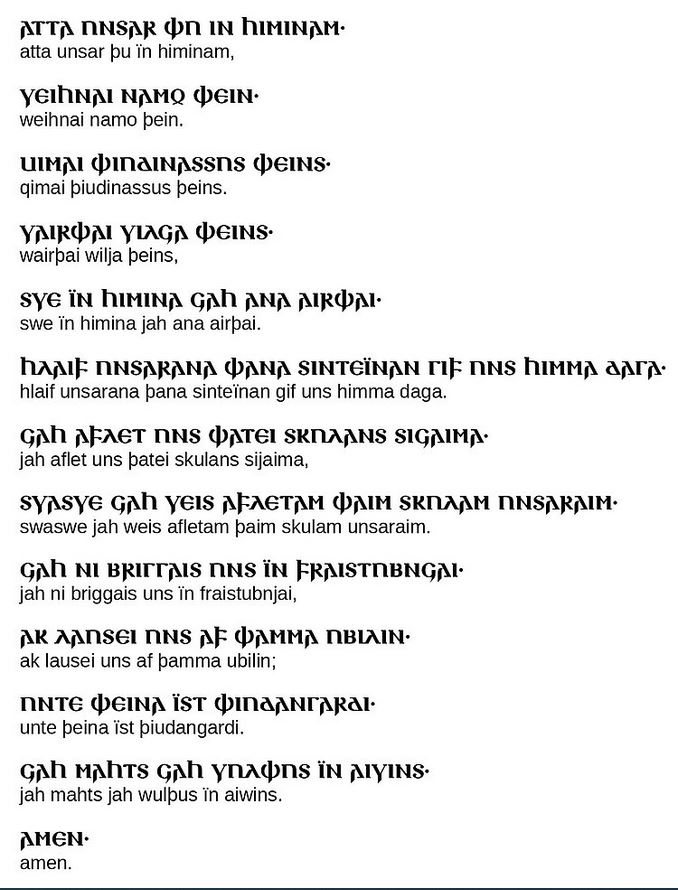
The Lords Prayer
THE Goths were a confederation of Germanic tribes, probably originating in Scandinavia. In the early centuries of our Common Era, they migrated as far south as the Black Sea and the river Danube, to the very outposts of the Roman Empire.
The first literary work produced in any Germanic tongue was the Gothic Bible. Today this translation exists only in fragmentary form. However, it remains a unique and valued version of the Holy Scriptures. Why?
Ulfilas—Missionary and Bible Translator
The translator of this Bible was Ulfilas, otherwise known by his Gothic name Wulfila. According to historian Philostorgius, Ulfilas was the descendant of captives taken in a Gothic raid into Cappadocia, now part of eastern Turkey. Born about 311 C.E., he was ordained by Eusebius of Nicomedia some 30 years later and trained to work as a missionary among the Goths.
“To instruct and multiply his converts,” says historian Will Durant, “he patiently translated, from the Greek into Gothic, all the Bible except the Books of Kings.” (The Age of Faith) Today, apart from a fragment of the book of Nehemiah, the only other Gothic Bible manuscripts extant are parts of the Christian Greek Scriptures.
Gothic was not a written language. Ulfilas therefore faced a translating challenge that called for exceptional ingenuity. Ancient ecclesiastical historians credit him with the invention of the Gothic alphabet of 27 symbols, based primarily on the Greek and Latin alphabets. Moreover, The New Encyclopædia Britannica remarks that “he coined a Germanic Christian terminology, some of which is still in use.”
Early History of the Gothic Bible
Ulfilas finished his translation before 381 C.E. and died two or three years later. The popularity of his work is attested to by The Encyclopedia Americana, which says that “the translation was generally used by the Goths who migrated to Spain and Italy.” Indeed, judging by the number of surviving fragments, it appears that many copies of this Gothic Bible were made. Likely, several manuscripts were produced in the scriptoria of Ravenna and Verona, in the area where the Goths had established their kingdom. The scriptoria were rooms in monasteries where manuscripts were written and copied.
The Goths came to their end as a nation about 555 C.E., after Byzantine emperor Justinian I had reconquered Italy. After their demise, says Tönnes Kleberg, “the Gothic language and Gothic traditions in Italy disappeared, leaving scarcely a trace. Manuscripts in Gothic were no longer of any interest. . . . They were to a large extent taken apart and scraped to remove the writing. The expensive parchment was then used again for writing new contents.”
Surviving Manuscripts
On some of these manuscripts, the erasure was imperfectly done, leaving the original script still faintly visible. Several of these palimpsests, as they are called, have been found and deciphered. Remarkably, the famous Codex Argenteus, containing the four Gospels in the order Matthew, John, Luke, and Mark, was preserved unscathed.
This splendid codex is thought to have originated in the Ravenna scriptorium at the beginning of the sixth century C.E. It is called Codex Argenteus, meaning “Silver Book,” because it is written in silver ink. Its leaves of parchment are dyed purple, indicating that it was probably commissioned for a royal personage. Gold letters embellish the first three lines of each Gospel as well as the beginnings of the different sections. The names of the Gospel writers also appear in gold at the top of the four parallel “archways” placed at the foot of each column of script. These give references to parallel passages in the Gospels.
Restoring the Gothic Bible Text
Following the dissolution of the Gothic nation, the valuable Codex Argenteus vanished. It was not seen again until it came to light in the middle of the 16th century in the monastery of Werden, near Cologne, Germany.
In the year 1569, the Gothic version of the Lord’s Prayer was published, drawing attention to the Bible from which it had been taken. The name Codex Argenteus appeared in print for the first time in 1597. From Werden this manuscript came to be in the emperor’s art collection in Prague. At the end of the Thirty Years’ War in 1648, however, the victorious Swedes carried it off along with other treasures. Since 1669 this codex has held a permanent place in the Uppsala University Library, Sweden.
The Codex Argenteus was originally composed of 336 leaves, 187 of which are in Uppsala. One other leaf—the last one of Mark’s Gospel—was discovered in 1970 at Speyer, Germany.
From the moment the codex reappeared, scholars began to study the script to unravel the meaning of the dead Gothic language. Using all available manuscripts and previous attempts at restoring the text, German scholar Wilhelm Streitberg put together and published in 1908 “Die gotische Bibel” (The Gothic Bible), with the Greek and Gothic texts on opposite pages.
Today, this Gothic Bible is of interest mainly to scholars. The fact that it was produced and cherished in the early days of Bible translating, however, testifies to Ulfilas’ desire and determination to have God’s Word translated into what was then a modern tongue. He correctly recognized that only by this means could the Gothic people hope to understand Christian truth.
